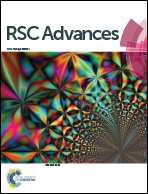Single-layer graphyne membranes for super-excellent brine separation in forward osmosis
Abstract
Forward osmosis (FO) technology has shown great promise in sea water desalinization and in power generation from the mixing of fresh water and seawater in estuaries. However, the desalination efficiency and the power density level of present FO systems are very low owing to the low water flux of commercial FO membranes. In this study, we report the brine separation performance of single-layer graphyne-N (N = 3, 4, 5, 6) membranes in a forward osmosis system by a molecular dynamics simulation. Our calculations show that graphyne-3 not only can achieve a high water flux of up to about 39.15 L cm−2 h−1, which is three to four orders of magnitude higher than that of conventional osmotic membranes, but also can achieve a perfect salt rejection rate. The results indicate that structural characteristics and charge properties of these membranes, as well as the distribution pattern of both water molecules and salt ions in each system, are the main factors that affect the brine separation performance of graphyne membranes. Besides, we found that the formation of hydrated salt ions is the basic reason for brine separation in salt solutions. Graphyne membranes have good prospects in brine separation, regeneration-free applications and high salinity applications in FO.


 Please wait while we load your content...
Please wait while we load your content...